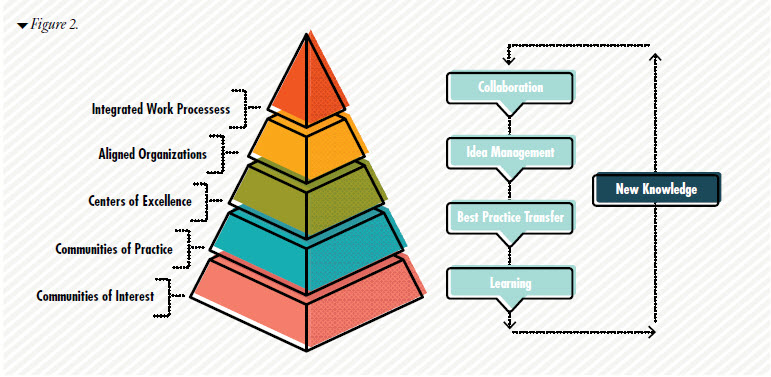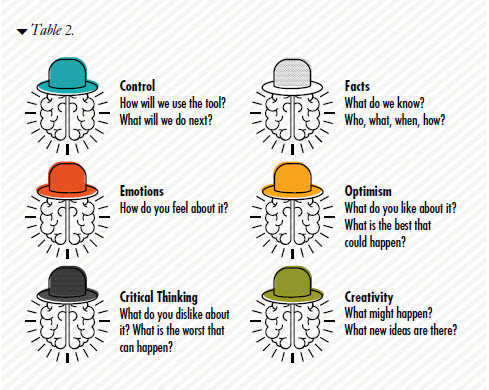Effective Knowledge Management Tools and Techniques
For every organization, people are the key asset. Their knowledge defines what the business knows and can accomplish

Charles Steinmetz, the wizard of Schenectady, was the most famous electrical engineer of his day. The story goes that when Henry Ford had exhausted the Ford Motor Company’s resources trying to fix a large electrical generator, he called on Steinmetz for help.1 Steinmetz arrived in Detroit and called for a pencil, paper, chalk, and a cot. After two days, he drew a line on the generator’s housing and asked the technicians to replace 16 wire windings. He submitted a bill for $10,000, a large sum in those days. Ford, surprised, requested an itemized invoice. Steinmetz replied:
- $1 to draw a chalk line
- $9,999 to know where to draw it
Ford paid the bill.
For every organization, people are the key asset. Their knowledge defines what the business knows and can accomplish. The knowledge of the staff is also constantly changing, and the knowledge needed for the organization is constantly changing too. This presents lab managers with several key knowledge management challenges, including how to identify:
- The knowledge possessed by the people
- The knowledge that is unique
- New knowledge needed by the organization
- How to effectively share and transfer knowledge
The knowledge owned by an organization can be located in numerous places. Most labs are familiar with the variety of concrete knowledge or documented knowledge around the lab. Familiar documents containing important knowledge include reports, notebooks, methods, databases, shared drives, and hard drives. The aspect of the organization’s knowledge more difficult to identify and locate is the tacit knowledge contained in people’s heads.
Knowledge management is a set of processes and tools to address this organizational need. Here is a set of proven knowledge management processes and tools that will benefit most lab managers:
- Identification of critical knowledge (TVA grid)
- Knowledge-retention tools
- Knowledge mapping
- Communities of practice
- Idea management
- DeBono’s six hats
- Best-practice sharing
- Lessons learned
Each of these tools will be discussed in this article.
Knowledge management tools
Critical knowledge grid
The critical knowledge grid2 used by the Tennessee Valley Authority (TVA) is an excellent tool to map who has the critical knowledge and how much risk there is of losing it. Figure 1 shows the TVA critical knowledge grid.
| Leave within 2 years | |||||
| Leave within 6 years | Duplicate skills exist in company or easy to get in market | Tacit knowledge but easy to transfer | Tacit knowledge critical to going forward; hard to find in the market | ||
| Criticality of knowledge | |||||
| Generally known | Irreplaceable | ||||
The lab manager can use the grid to document and manage knowledge transfer based on which staff have what levels of critical knowledge and when they might be expected to leave the organization. Retirement is not the only reason, as people often exit the organization for transfers, promotion, or personal reasons, so being aware of workforce transitions is critical.
Knowledge retention tools
Sharing knowledge with colleagues is an excellent way to retain knowledge within the organization. Lab managers should use the tools in Table 1 during cross-training to retain specific knowledge in the organization.
| Tacit Tools | Explicit Tools |
| Storytelling | Documentation |
| On the Job Training | On the Job Training |
| Mentoring | Wiki |
| Lessons Learned | |
| Shadowing | |
| Wiki |
Storytelling enables senior staff to tell some of their favorite stories, and they usually talk about why in addition to what and how. Effective examples of how NASA uses storytelling to transfer knowledge are given in DeLong.3
On-the-job training and shadowing are related tools. In shadowing, the student watches the teacher execute a task, and in on-the-job training, the teacher watches the student work.
Mentoring provides the opportunity to pass not only tactical knowledge but also culture from experienced staff to younger people.
Writing internal wikis enables staff to explain pertinent details of the work and explain why different decisions are made.
Lessons learned enable the lab manager to establish a learning culture and take advantage of both positive and negative outcomes for learning for the whole organization.
Knowledge mapping
Knowledge mapping4 enables the lab manager to choose a specific process important to the organization and follow who requires specific elements of knowledge, who has it, and when it is needed. For many technical organizations, the knowledge map resembles other process maps that are familiar to technical staff.
There are several benefits of constructing knowledge maps. The process of creating the map forces lab managers to think critically about what knowledge is needed. Using the maps emphasizes the importance of knowledge sharing and generates an effective tool for less-experienced staff. Of course, there are also challenges in creating effective knowledge maps, including getting the right people in the room and motivating people to share and manage organizational knowledge instead of hoarding knowledge. As with any other effective business process, an important challenge is to institutionalize the process so that the knowledge is always up to date.
Community of practice
Figure 2 shows the Air Products knowledge management model based on communities of practice.5
 Figure 2.
Figure 2.
Communities of practice (COPs) are focused on a general area of interest. The object is to bring a group of volunteers together with responsibility to achieve the community's business goals. COPs are self-managed, hold regular meetings and events, and communicate regularly about the benefits they generate. The outcome of a COP is to nurture knowledge sharing and mutual learning from others within the community.
Idea management5
New challenges require new ideas. As lab managers, we need to have mechanisms to encourage, attract, and evaluate new ideas. There are many ways to ask for new ideas; for example, a physical idea box, a virtual idea box, email, dropping by to chat, the Internet, networking, and brainstorming. A management process that requires active management of ideas through submittal and workflow will work well for an organization.
Once new ideas are generated, the ideas need to be sorted and evaluated. Mind-map software6 or other nonlinear tools can be very effective in sorting new ideas. All new idea submissions must be evaluated. That needle in the haystack may be there. In addition, all submitters must be notified about their ideas. Lack of feedback will stifle the flow of good ideas. Good ideas need to be developed. Some relatively small fraction of ideas will hit the mark.
De Bono’s six hats
All humans carry unintended bias into most decisions. Lab managers need ways to counter the natural bias. Some common biases that need to be addressed include:
- Confirmation bias—selective search for evidence
- Premature termination—accepting the first alternative that might work
- Cognitive inertia—unwillingness to change
- Selective perception—screening out information
- Wishful thinking—seeing things in a certain (usually positive) light
- Choice-supportive bias—distortion of memories of chosen and rejected options to make the chosen options seem more attractive
One useful tool to counter unintended bias is de Bono’s six hats.7 Using the tool provided by de Bono enables a more objective way to evaluate ideas or make decisions. The six hats approach enables a group to effectively consider all sides of an issue. Everyone wears the same hat at the same time, and everyone participates in every part of the discussion.
Table 2 shows the six hats.
 Table 2.Once the new ideas have been sorted and evaluated, some can be tried. The good old scientific method is often a good way to experiment with new ideas. Demonstrated ideas can be implemented. Implemented ideas can be good practices. Some good practices can become best practices— maybe it will work for someone else too.
Table 2.Once the new ideas have been sorted and evaluated, some can be tried. The good old scientific method is often a good way to experiment with new ideas. Demonstrated ideas can be implemented. Implemented ideas can be good practices. Some good practices can become best practices— maybe it will work for someone else too.
Best practices
A best practice is the current best way of doing work that has been implemented.5 The method is generating measurable benefits, and the idea can be replicated elsewhere in the company.
Best-practice sharing brings many advantages to the organization, including helping it:
- Save money
- Share best vendors and pricing
- Rapidly share proven solutions to common problems
- Rapidly get input on possible solutions
- Seek proven solutions
- Rapidly share experience globally to related operations
- Connect people from different areas, businesses, or regions
- Rapidly share opportunities
Lessons learned
As mentioned above in the discussion of knowledge retention tools, lessons learned can be a powerful tool to create and propagate a learning culture. A popular and highly effective process for the capture and fast transfer of lessons learned is the after-action review.8 Lessons learned are designed to enable individual and organizational learning. The tool can be utilized before, during, or after any event or project. The lessons learned approach is primarily a tacit knowledge tool; participation is the key. It brings insight to not only what, how, or when things were done but also why they were done.
A lessons learned tool consists of five questions:
- What did you expect to happen?
- What actually happened?
- Why did it happen?
- What can we learn?
- What do we need to do based on our learning?
Both positive and negative results should be discussed. To enable full participation, no blame or finger-pointing is allowed.
Lessons learned can bring significant benefits to the organization:
- Create a culture of learning
- Create a psychologically safe environment
- Share what people know
- Prevent the repetition of undesirable outcomes
- Appreciate new ideas
- Impart tacit knowledge that is difficult to express in writing
- Give background, context, and history; explain why
- Describe issues encountered
- Reveal how problems were solved
- Help align a team with their work
Summary
Knowledge is critical for any organization. Lab managers need to know the who, where, when, why, and how of a high number of different processes and protocols. To be successful in this role, the lab manager needs proficiency in a number of different knowledge management tools, a number of which were reviewed in this paper. A strong knowledge management program will retain critical knowledge, seek new knowledge, and generate a learning organization.
Acknowledgments
The authors would like to acknowledge colleagues past and present at Intertek, Lehigh University, and Air Products.
References:
2. Moria Levy (2011), “Knowledge retention: minimizing organizational business loss,” Journal of Knowledge Management, Vol. 15, Issue 4, pp. 582-600.
3. DeLong, David, Lost Knowledge: Confronting the Threat of an Aging Workforce, Oxford University Press, New York, New York, 2004.
4. APQC, Knowledge Mapping Concepts and Tools (Collection), https://www.apqc.org/knowledge-base/collections/knowledge-mapping-concepts-and-tools-collection
5. APQC, The Air Products Profile: Best Practices in Integration, APQC Publications, Houston, TX, 2007.
6. FreeMind, http://freemind.sourceforge.net/wiki/index.php/Main_Page
7. De Bono, Edward, Six Thinking Hats, Little, Brown and Company, New York, 1985.
8. Collison and Parcell, Learning to Fly: Practical Knowledge Management from Leading and Learning Organizations, Capstone Publishing Limited (Wiley), 2004.

